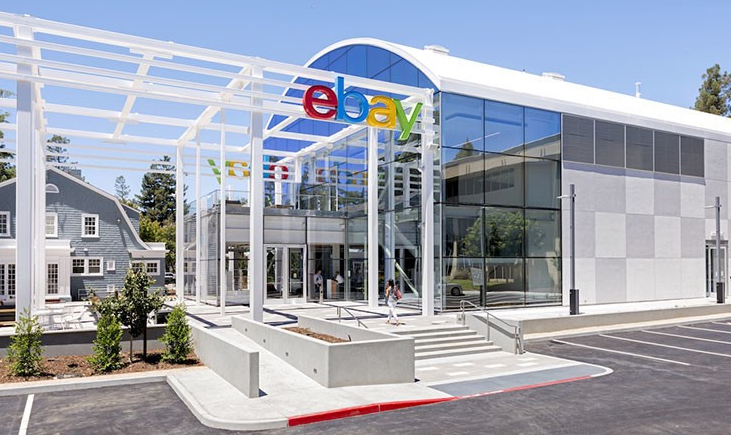by Tom Konrad, Ph.D., CFA
Of the few survivors of the dot com bust, Ebay (EBAY) is a perennial also-ran. It owned the market for consumer-to-consumer (C2C) transactions in 2000, but has since repeatedly lost market share. Nevertheless, the company remains a profitable business that enables the sustainable reuse of easy to ship items while returning cash to investors.
Note: My supporters on Patreon got an early look at this article. Want to support my work and get previews of my writing? Join them here.

The Competition for Sellers
In the early 2000s, Ebay lost sellers to Amazon’s (AMZN) marketplace, which had the advantage of getting listings in front of a larger group of buyers, and has since added more services for sellers, such as delivery services through Amazon’s impressive logistics arm. More recently, specialist competitors like Etsy (ETSY) for crafts , and PoshMark for fashion have attracted younger users who prefer an app-based interface.
Many sellers prefer Ebay for its lower fees compared Amazon and other competitors, and its pure customer to customer model means that it has no inventory or warehouses, and its operations are not disrupted by trying to maintain social distancing. Other sellers list on multiple platforms, but offer better prices on Ebay because of the lower transaction fees.
This is why I believe that social distancing is an opportunity for Ebay to claw back some market share from Amazon. The stories of third party sellers being second class citizens on Amazon’s platform have been prevalent for years, most notably Amazon using its data to directly compete with third party sellers in any category that it starts to see as particularly profitable. Sellers can succeed quickly through access to Amazon’s legion of buyers on its Marketplace, but if they become too successful, they will likely find themselves competing with Amazon itself.
Sellers discovered another problem with their reliance on Amazon when the company decided to prioritize the delivery of “essential” items in March. While prioritizing life saving items over toys and knick-knacks is likely a good use of Amazon’s overtaxed warehouse workers, this is small consolation to a small online seller who needs the income to buy their own essential items. These frustrations will likely lead sellers to be less likely to trust all their eggs to Amazon’s basket.
Looking Forward
Ebay’s revenues, and number of sellers and buyers have been basically flat in recent years, and the company did not expect that to change when it issued its guidance for 2020 at the end of January. The company did expect single digit earnings per share growth, driven mostly by share repurchases.
Those share repurchases and the new dividend were motivated by activist investors who have forced the company to start returning value to shareholders in the absence of growth. The company now has a new CEO and two new board members nominated by the activists. They have also led Ebay to consider the sale of some of its properties, including the very fortuitously timed sale of StubHub for $4.05 billion (approx $5/share) in February. Further shoring up the balance sheet, Ebay followed this sale by refinancing and extending the term $1 billion of its senior unsecured debt with lower interest notes due in 2030.
Before the crisis, the expectation had been that Ebay would use its strong cash position to invest in its platform, and accelerate its stock buybacks. The new reality means that Ebay is in a good position to be a consolidator by buying up less well prepared rivals.
Sustainability
For me, “Reduce, Reuse, Recycle” is not just an alliterative list of sustainable actions which I incorporate in my personal life, it’s also a list of investing themes I try to incorporate in my portfolio. For reduce, I have stocks that incorporate energy efficiency like Hannon Armstrong (HASI) and Ameresco (AMRC). For recycle, I have Umicore (UMICF, UMICY, UMI.BR), Schnitzer Steel (SCHN), and Greystone Logistics (GLGI). The essentially anti-consumerist nature of reuse makes it a particularly difficult investing theme to participate in.
I’ve wanted to include Ebay or another C2C marketplace as the first “Reuse” stock in my portfolio for a long time, but until recently, Ebay’s valuation and lack of dividend have kept me away. The recently initiated dividend and stock decline have changed that. Combine that now with potential opportunities to claw back market share from Amazon and potentially purchase distressed rivals, and I’m buying.
Or at least I’m selling cash-covered puts on Ebay. I like to think of buying a stock as a bet that it will go up, or, if it doesn’t, that the dividend will exceed any decline. Selling a cash-covered put, or buying the stock and selling a covered call are similar strategies that I think of as bets that the stock will not fall permanently. If the stock falls below the option strike price, the investor will own the stock at a cost below what it was trading at when the bet was made. If the stock rises, the investor keeps the option premium and cash.
In terms of Ebay’s prospects, the company is cash rich, and its operations are unlikely to be disrupted by the pandemic. It may even see some upside. The loss of income for too many people in this crisis will lead some to explore new ways to earn cash. Selling off unneeded stuff on online platforms is an easy and quick option, especially people who want to avoid in person transactions.
Trading
Good valuation, a strong balance sheet, opportunities arising from people staying at home, and overall sustainability all led me to use a cash covered Ebay put as a new position in my 10 Clean Energy Stocks model portfolio at the start of the month.
The market and Ebay stock fell the following day, and have since recovered, so readers who follow the model portfolio would have had an opportunity to make the trade. If you missed that window, I expect the market to remain volatile in both directions for months to come as investors sort out what this pandemic and the response to it mean for the economy.
It is that expected volatility that leads me to prefer cash covered puts to the direct purchase of stocks in current market conditions. If your account does not have sufficient options permission to sell cash covered puts, purchasing the stock and selling a covered call has the exact same risk/reward profile.
If you do not have options permission at all, watching several stocks you think are good prospects and starting with a small position which you increase if the stock falls is probably the best option. Unfortunately, that strategy is difficult for anyone who does not pay daily attention to the market.
Disclosure: Long HASI, EBAY, UMICF, SCHN. Small long positions in AMRC and GLGI.
DISCLAIMER: Past performance is not a guarantee or a reliable indicator of future results. This article contains the current opinions of the author and such opinions are subject to change without notice. This article has been distributed for informational purposes only. Forecasts, estimates, and certain information contained herein should not be considered as investment advice or a recommendation of any particular security, strategy or investment product. Information contained herein has been obtained from sources believed to be reliable, but not guaranteed.





